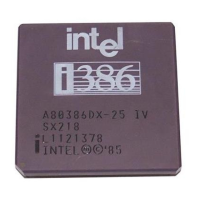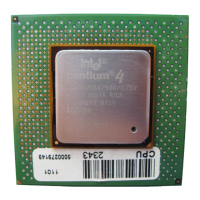January 2007 97
Intel
®
855GME Chipset and Intel
®
6300ESB ICH Embedded Platform Design Guide
connections between the DATA and ADDR sides of the Intel Pentium M/Celeron M processor
socket on the secondary side and the V
CCP
flood for all DATA, ADDR, and legacy side V
CCP
pins
on the primary side (see Figure 44).
In reality, the north and south sides of the V
CC-CORE
floods are bridged by means of V
CC-CORE
planes in Layers 3, 5, and 6 as illustrated in Figure 46. Layers 3, 5, and 6 connect the V
CC-CORE
stitching vias next to the negative terminals of the nine capacitors on the north side with the
V
CC-CORE
stitching vias next to the negative terminals of the nine capacitors on the south side.
Layers 3, 5, and 6 V
CC-CORE
corridors use the fact that there are no Intel Pentium M/Celeron M
processor FSB signals routed under the shadow of the Intel Pentium M/Celeron M processor socket
cavity. All the V
CC-CORE
pins of the Intel Pentium M/Celeron M processor pin-map shall connect
to the internal V
CC-CORE
planes of Layers 3, 5, and 6.
Special attention shall be given to not route any of the Intel Pentium M/Celeron M processor FSB
or any other signal in a way that would block V
CC-CORE
connections to all the V
CC-CORE
power
pins of the Intel Pentium M/Celeron M processor socket in Layers 3, 5, and 6. Figure 46 also
depicts how the V
CC-CORE
planes on Layers 3, 5, and 6 make an uninterrupted connection all the
way from the SP capacitors and sense resistors in the north side of the V
CC-CORE
corridor up to the
south side of the 24 V
CC-CORE
pins of the Intel Pentium M/Celeron M processor socket. This
continuous connection is imperative on all three internal layers because neither the primary nor the
secondary side V
CC-CORE
floods make one continuous, robust connection from ‘north to south.’
The remaining three 10 µF, 0805 capacitors are placed on the primary side immediately above the
shadow of the three 0805 capacitors on the secondary side and are placed at the same pitch
(90 mils) as shown in Figure 44 and Figure 45. Two are on the side closest to the signal column 24
and 25 of the Intel Pentium M/Celeron M processor pins while one is on the side closest to signal
column 2. The area between these three capacitors may be efficiently used for VRM sense resistor
connections as illustrated in the primary side zoom view in Figure 45.
Special care shall be taken to provide a robust connection on the V
CC-CORE
floods on the primary
side from the sense resistors to the V
CC-CORE
corridor pins on the north side of the Intel Pentium
M/Celeron M processor socket. This robust connection is needed due to the presence of the GND
dog bones on the primary side. The specific arrangement of V
CC-CORE
and GND vias as shown in
Figure 45 shall be closely followed to provide a robust connection to the V
CC-CORE
floods for
ALL V
CC-CORE
BGA balls and vias on the primary side in the AF, AE, AD, AC, AB, AA, Y, W, V,
and U signal rows of the Intel Pentium M/Celeron M processor socket connecting all the way up to
V
CC-CORE
stitching vias next to negative terminals of the nine 0805 capacitors placed under the
socket cavity shadow.
Figure 47 depicts a magnified view of the recommended layout for the SP capacitor connections to
minimize their inductance on the secondary side (Layer 8) of the motherboard. The V
CC-CORE
pin
side of the capacitor has two V
CC-CORE
vias placed 82 mils above the V
CC-CORE
pad of the SP
capacitor within the shadow of the SP capacitor. These two V
CC-CORE
vias are paired with two
GND vias with a 50-mil offset to reduce the inductance of the connection between the capacitor
and the plane. An additional pair of GND vias are placed 82 mils below the ground pad of the SP
capacitor (also under the shadow of the SP capacitor body) to allow efficient stitching of ground
planes on Layers 1, 2, 4, 7, and 8 in this area. Outside the shadow of the SP capacitors, the
V
CC-CORE
/GND via pairs of the SP capacitors are shared with the V
CC-CORE
/GND via pairs of the
0805 capacitors. The placement of additional vias is not advised because this results in excessive
perforation of the internal power planes due to the antipad voids. The pitch between the SP caps is
220 mils (or closer).
The layout concepts described in Figure 44 through Figure 47 result in an estimated V
CC-CORE
effective resistance of 0.58 m
Ω and an effective inductance of ~4 pH. Despite the use of multiple
power planes, this is still significant compared to the 3 m
Ω load line target resistance and

